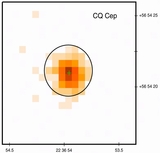A Chandra Observation of the Eclipsing Wolf-Rayet Binary CQ Cep
Abstract
The short-period (1.64 d) near-contact eclipsing WN6+O9 binary system CQ Cep provides an ideal laboratory for testing the predictions of X-ray colliding wind shock theory at close separation where the winds may not have reached terminal speeds before colliding. We present results of a Chandra X-ray observation of CQ Cep spanning ~1 day during which a simultaneous Chandra optical light curve was acquired. Our primary objective was to compare the observed X-ray properties with colliding wind shock theory, which predicts that the hottest shock plasma (T >~ 20 MK) will form on or near the line-of-centers between the stars. The X-ray spectrum is strikingly similar to apparently single WN6 stars such as WR 134 and spectral lines reveal plasma over a broad range of temperatures T ~ 4-40 MK. A deep optical eclipse was seen as the O star passed in front of the Wolf-Rayet star and we determine an orbital period P orb = 1.6412400 d. Somewhat surprisingly, no significant X-ray variability was detected. This implies that the hottest X-ray plasma is not confined to the region between the stars, at odds with the colliding wind picture and suggesting that other X-ray production mechanisms may be at work. Hydrodynamic simulations that account for such effects as radiative cooling and orbital motion will be needed to determine if the new Chandra results can be reconciled with the colliding wind picture.
- Publication:
-
The Astrophysical Journal
- Pub Date:
- February 2015
- DOI:
- 10.1088/0004-637X/799/2/124
- arXiv:
- arXiv:1411.4075
- Bibcode:
- 2015ApJ...799..124S
- Keywords:
-
- stars: individual: CQ Cep WR 155 HD 214419;
- stars: Wolf-Rayet;
- X-rays: stars;
- Astrophysics - Solar and Stellar Astrophysics
- E-Print:
- 31 pages, 4 figures
